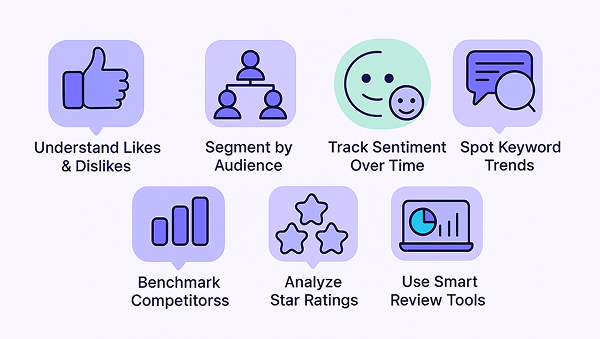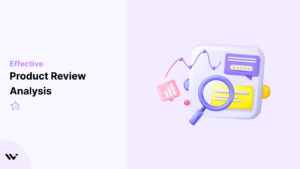Everyday, people leave online reviews about products and services they use. These reviews—whether on Google, social media platforms, app stores, or your own website—are full of useful information.
When you analyze customer reviews the right way, you can get valuable insights about what your customers feel, what they like, and what needs improvement.
Knowing how to analyze reviews helps you spot positive reviews, negative comments, and trends that show what your current customers expect.
With the right review analysis tools or even an AI-powered analysis tool, you can turn all that unstructured data into actionable insights that guide your business.
This guide shows why review analysis matters, how to use analysis tools, and how to read customer sentiment and star ratings to understand your brand reputation.
Whether you run a small shop or a big customer-focused company, learning to respond to customer feedback can improve your services, keep customers happy, and build a strong brand reputation.
Let’s get started!

What is Review Analysis?
Review analysis is the process of looking closely at customer feedback from online reviews, review sites, and even social media posts to understand how customers feel about a product or service.
It helps businesses analyze customer reviews to spot trends, pain points and features people love or dislike.
By using review analysis tools or an AI-powered analysis tool, companies can quickly scan large amounts of review data, perform sentiment analysis, and gain actionable insights.
This helps improve customer experience, boost brand reputation, and support smart decision-making.
In short, review analysis is important because it helps businesses better understand their customers’ opinions, meet customer expectations, and make informed decisions for growth.
How WiserReview Makes Product Review Analysis Simple and Clear

WiserReview gives you a clean and structured way to understand what customers say about your products.
Instead of reading every review manually, you can use filters, tags, and smart insights to break down large volumes of feedback into clear points.
This helps you find trends, fix product issues, and highlight what people love most.
WiserReview features that simplify analysis:
AI Review Tags: WiserReview automatically adds tags to each review based on common keywords or topics. You can easily group reviews by product features, delivery experience, or customer support. This helps you understand what people care about the most.
Sentiment Analysis: The system identifies if a review is positive or negative. Positive reviews are published instantly. Negative ones are held back, so you can check and respond before they go live. This protects your brand and gives you time to fix real issues.
Auto Replies: You don’t have to write replies from scratch. WiserReview drafts replies for reviews collected through Google or other channels. You can approve, edit, or post as is. This saves time while keeping your response rate high.
Highlight Key Words: Important words like “fast delivery” or “poor service” are highlighted inside reviews. You can set the color for both background and text. This makes it easier to scan feedback and spot what stands out most to your buyers.
Social Media Auto-Posts (Coming Soon): WiserReview will soon allow you to auto-share selected reviews on Facebook and Instagram. It will pick your top-performing reviews and turn them into banners. This adds social proof to your feeds without extra work.
Other Main Features:
Review Collection Automation: Send review requests automatically through email, WhatsApp, or thank-you pages.
Manual and Queue Mode: Review each request before sending or
bulk requests from a queue.
Incentives: Add discount codes or offers to motivate customers to leave a review.
Review Forms: Create custom forms to collect text, photo, or video reviews.
Display Widgets: Use sliders, carousels, badges, or walls of love to show reviews on your website.
Product-Specific Widgets: Highlight reviews for specific items using star ratings, avatars, or nudges.
Rich Snippets: Add schema markup to show star ratings in Google search results.
Google Reviews Integration: Import and manage Google reviews directly from your dashboard.
Each of these tools works in real-time to give you better control, better clarity, and better decisions based on what your customers are saying. You don’t need to install anything extra or spend hours filtering data. Just turn them on and focus on what matters.
Smarter Review Analysis, Less Effort
Auto-reply, share top reviews, and manage it all in one place.
Importance of Review Analysis in Modern Business

Understanding what your customers are saying has never been more important.
With millions of people leaving feedback through online reviews, social media posts, and review sites like Google Reviews and app stores, there’s a massive amount of valuable insights waiting to be uncovered.
When you analyze customer reviews properly, you get a clearer picture of what’s working, what’s not, and what your customers really want.
A recent study shows that 93% of users say online reviews impact their buying decisions. Businesses that regularly analyze reviews often see higher customer retention and brand loyalty because they act on what customers are actually saying.
So why is review analysis important today? Here’s a simple breakdown:
- Understand customer sentiment: Use sentiment analysis to get the overall sentiment behind both positive reviews and negative comments.
- Spot trends and pain points: Identify areas where your product or service needs improvement based on recurring feedback.
- Improve brand reputation: Responding to customer feedback and making changes can lead to more positive reviews and a stronger brand reputation.
- Make informed decisions: Review data offers real, firsthand customer opinions—perfect for decision making when launching new features or improving current services.
How Review Analysis Works – A Step-by-Step Process
Understanding how review analysis works is key to uncovering real customer insights, improving product strategies, and enhancing user satisfaction.
Here’s a simple, step-by-step breakdown of the entire review analysis process:
Step 1: Gather Reviews from Multiple Sources
Start by collecting reviews from every relevant platform—your website, e-commerce sites like Amazon or Shopify, social media, and third-party review platforms like Trustpilot or Yelp. A wide range of sources gives you a more complete view of what customers are saying.
Step 2: Clean and Prepare the Data
Raw review data can be messy. You’ll need to clean it by removing spam, irrelevant content, and duplicates. Normalize the formatting and fix obvious spelling or grammar issues. This step ensures your analysis is accurate and meaningful.
Step 3: Categorize the Reviews
Sort reviews into categories based on topics customers mention—like product quality, customer service, delivery, price, usability, etc. This helps you focus on specific areas of interest or concern.
Step 4: Perform Sentiment Analysis
Use sentiment analysis to determine the tone of each review. Is the customer happy, frustrated, neutral, or mixed? This helps you quantify overall customer satisfaction and identify areas that need attention.
Step 5: Identify Common Themes and Keywords
Analyze the text for recurring keywords, phrases, or complaints. For example, if many reviews mention “battery life” or “slow shipping,” those are themes worth exploring. This step helps highlight patterns you might otherwise miss.
Step 6: Visualize the Findings
Turn your analysis into charts, word clouds, or dashboards. Visualization helps you quickly spot trends—like a spike in negative reviews after a product update—and makes it easier to share findings with your team.
Step 7: Take Action Based on Insights
The final and most important step is using what you’ve learned. Improve the product, respond to complaints, update FAQs, or retrain your support team. Review analysis only matters if it leads to smarter decisions.
Build trust & FOMO
Highlight real-time activities like reviews, sales & sign-ups.
7 Powerful Ways to Review Analysis for Smarter Business

Understanding how your customers feel about your product or service is essential. By taking the time to analyze customer reviews, you’re not just seeing ratings—you’re diving into real customer feedback that can shape smarter business decisions. Let’s explore seven effective ways to analyze reviews and use that data to build a more customer-centric company.
1. Understand What Customers Like and Dislike
The first step in review analysis is looking for patterns in positive reviews and negative comments. Whether on Google reviews, social media platforms, or your own website, customer opinions offer real-world clues.
- Pinpoint the most talked-about features—good and bad
- Identify pain points your customers face regularly
- Spot what makes customers leave more positive reviews
This helps you make informed decisions based on what your current customers really want.
2. Organize Review Data by Audience
Your customers aren’t all the same, so neither are their experiences. Segmenting reviews based on the type of user or location can help you tailor your services or product improvements.
- Group feedback by product versions, locations, or platforms (like app stores)
- Understand how different groups experience your business
- Use this data to better align with customer expectations
This kind of segmentation leads to a better understanding of customer needs and behavior.
Build trust & FOMO
Highlight real-time activities like reviews, sales & sign-ups.
3. Track Sentiment and Emotions Over Time
It’s not enough to count star ratings—you should also try to analyze the sentiment in the reviews. This means figuring out the overall tone or customer sentiment behind the words.
- Look at how feelings change after launching new features or changes
- Spot trends in satisfaction or frustration
- Use sentiment analysis to measure your brand reputation
Keeping an eye on overall sentiment helps maintain a positive brand reputation and boosts customer retention.
4. Focus on the Most Common Keywords
One simple but powerful method is scanning reviews for frequently mentioned words and topics. This reveals which areas customers focus on most.
- Look for keywords like “price,” “fit,” or “support”
- Notice what customers talk about most across different review sites
- Use this feedback to identify areas for quick wins and long-term improvements
This is a great way to get valuable insights from large volumes of unstructured data.
5. Compare with Your Competitors
Another smart way to analyze customer reviews is by looking at what customers are saying about your competitors.
- Check online reviews of other companies offering similar products
- Find out what their customers love—and what they complain about
- Use that knowledge to refine your own customer experience
Understanding your competitors’ brand reputation gives your business an edge and helps build brand loyalty.
6. Dive Deeper Into Star Ratings
A 5-star review is great, but the real gold is often in the 2- to 4-star ones. Those reviews are usually more detailed and filled with actionable insights.
- Separate reviews by rating and reading the comments
- Find out why some customers rated you lower
- Understand what stops customers from giving full marks
This can lead to practical improvement ideas that truly matter to your audience.
7. Use Easy Review Analysis Tools
There are many review analysis tools out there that help make this process smoother and faster. You don’t need to rely only on manual tracking.
- Use software like Wiserreview or ReviewTrackers to process reviews
- Automate tasks like sentiment analysis and topic detection
- Get quick summaries to speed up your decision-making
Conclusion
In conclusion, effective product review analysis is more than skimming through star ratings—it’s about uncovering insights that truly reflect customer experiences.
By systematically examining both positive and negative feedback, spotting recurring patterns, and using analytical tools or manual methods to categorize sentiment and themes, businesses and shoppers alike can make smarter decisions.
For businesses, this kind of analysis can fuel product improvements, enhance customer satisfaction, and boost brand trust. For consumers, it offers a clearer picture of what to expect before making a purchase.
Whether you’re a marketer, seller, or savvy shopper, mastering the art of review analysis puts the power of informed decision-making right at your fingertips.
Show Real Reviews That Build Trust
Collect and display photo, video, and text reviews with full design control.






